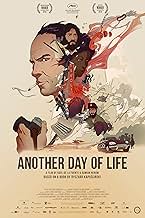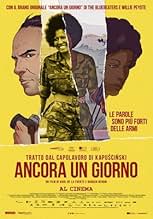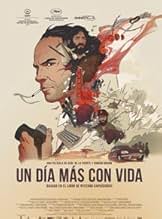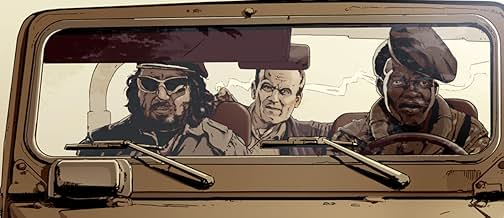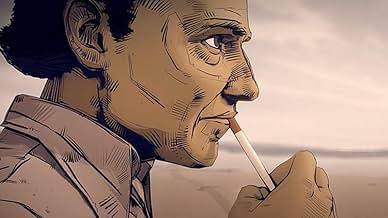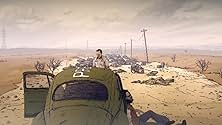Un día más con vida
- 2018
- 1 घं 25 मि
अपनी भाषा में प्लॉट जोड़ेंA gripping story of a three-month-long journey that renowned Polish reporter Ryszard Kapuscinski took across Angola, ravaged by a war in which the front lines shifted like a kaleidoscope, fr... सभी पढ़ेंA gripping story of a three-month-long journey that renowned Polish reporter Ryszard Kapuscinski took across Angola, ravaged by a war in which the front lines shifted like a kaleidoscope, from one day to the next.A gripping story of a three-month-long journey that renowned Polish reporter Ryszard Kapuscinski took across Angola, ravaged by a war in which the front lines shifted like a kaleidoscope, from one day to the next.
- पुरस्कार
- 14 जीत और कुल 9 नामांकन
- Self
- (as Luis Alberto)
- Self
- (आर्काइव फ़ूटेज)
- (as Carlota)
- Self
- (as Farrusco)
- Queiroz
- (as Vergil Smith)
- …
- Queiroz
- (वॉइस)
- Farrusco
- (वॉइस)
- Carlota
- (वॉइस)
- Friedkin
- (वॉइस)
- …
- Dona Cartagina
- (वॉइस)
फ़ीचर्ड समीक्षाएं
First, it's incredibly one-sided. For a work based on a journalist piece you would expect something that would recognize that there isn't "good or bad" in wars. We the purists vs the evil is something that simple doesn't happen and didn't happen in Angola at all. The MPLA killed, at least, as many as the other movements but that's not the impression you take from this. It would be good to show a bit about the other sides and their motivations (no, it was not only the American capitalism 😑).
Second, the story had a lot of potential but I just felt that it was not told in a compelling way. Yes, there are good parts. Yes, the bits about Carlota are emotional. Yes, some real testimonials are important. However, I felt that these episodes could have been told in a much more interesting way.
Third, I didn't feel this Angolan enough. You feel that this is made mainly for international consumption. People should have seen more from Angola; could have heard more about their music - so important during war times -; more about their traditions; at least, hear a bit more of Portuguese with the Angolan accent or some Angolan local languages.
The animation is good, it's always great to recognise some places and to tell about real stories (even if I'm not sure this format was the ideal). However, I feel this was much more a missed opportunity than anything else.
The animated sections are in the English language and the actual documentary pieces are in native tongues; but there are subtitles available so that you know what is said. It makes for a gripping and most thoroughly interesting watch and, is presented in an almost comic style very polished looking animated style. There is no one sided reporting as it tells the tale of the misery caused by both side and both superpowers; a misery that endured for the Angolan people for 27 years.
The film is well based on historical events , these are as follows : The country is in the midst of decolonization efforts, launched after the success of the Carnation Revolution. Portuguese nationals are hurriedly fleeing the more glamorous districts of Luanda. The war devastated Angola's infrastructure and severely damaged public administration, the economy and religious institutions.In the final months before the declaration of independence, different factions of the Angolan liberation movement were locked in a protracted struggle that would decide who would hold power in the coming republic. The war was a power struggle between two former anti-colonial guerrilla movements, the communist People's Movement for the Liberation of Angola (MPLA) and the anti-communist National Union for the Total Independence of Angola (UNITA). The war was used as a surrogate battleground for the Cold War by rival states such as the Soviet Union, Cuba, South Africa and the United States.The MPLA and UNITA had different roots in Angolan society and mutually incompatible leaderships, despite their shared aim of ending colonial rule. A third movement, the National Front for the Liberation of Angola (FNLA), having fought the MPLA with UNITA during the war for independence, played almost no role in the Civil War. Additionally, the Front for the Liberation of the Enclave of Cabinda (FLEC), an association of separatist militant groups, fought for the independence of the province of Cabinda from Angola.The Angolan Civil War was notable due to the combination of Angola's violent internal dynamics and the exceptional degree of foreign military and political involvement. The war is widely considered a Cold War proxy conflict, as the Soviet Union and the United States, with their respective allies, provided assistance to the opposing factions. The conflict became closely intertwined with the Second Congo War in the neighbouring Democratic Republic of the Congo and the South African Border War.Angola's three rebel movements had their roots in the anti-colonial movements of the 1950s.The MPLA was primarily an urban based movement in Luanda and its surrounding area.It was largely composed of Mbundu people. By contrast the other two major anti-colonial movements the FNLA and UNITA, were rurally based groups.The FNLA largely consisted of Bakongo people hailing from Northern Angola. UNITA, an offshoot of the FNLA, was mainly composed of Ovimbundu people from the Central highlands
MPLA : Since its formation in the 1950s, the MPLA's main social base has been among the Ambundu people and the multiracial intelligentsia of cities such as Luanda, Benguela and Huambo.During its anti-colonial struggle of 1962-74, the MPLA was supported by several African countries, as well as by the Soviet Union. Cuba became the MPLA's strongest ally, sending significant contingents of combat and support personnel to Angola. This support, as well as that of several other countries of the Eastern Bloc, was maintained during the Civil War. Communist Yugoslavia provided financial military support for the MPLA, including $14 million in 1977, as well as Yugoslav security personnel in the country and diplomatic training for Angolans in Belgrade. The United States Ambassador to Yugoslavia wrote of the Yugoslav relationship with the MPLA, and remarked, "Tito clearly enjoys his role as patriarch of guerrilla liberation struggle." Agostinho Neto, MPLA's leader during the civil war, declared in 1977 that Yugoslav aid was constant and firm, and described the help as extraordinary. According to a November 1978 special communique, Portuguese troops were among the 20,000 MPLA troops that participated in a major offensive in central and southern Angola
UNITA's main social basis were the Ovimbundu of central Angola, who constituted about one third of the country's population, but the organization also had roots among several less numerous peoples of eastern Angola. UNITA was founded in 1966 by Jonas Savimbi, who until then had been a prominent leader of the FNLA. During the anti-colonial war, UNITA received some support from the People's Republic of China. With the onset of the civil war, the United States decided to support UNITA and considerably augmented their aid to UNITA in the decades that followed. However, in the latter period, UNITA's main ally was the apartheid regime of South Africa
This animated documentary involves both poles from the Cold War, and is not, and cannot be by any means precisely a fruit of objectivity. But, as Kapuscinski put it in many other of his reporter works, and is put it that way on here, his job is to give word to those are condemned to be forgotten, those who usually die amidst oblivion and never are listen, those who are needed and poor, just like Jesus say on his preach, which not means I compared Jesus with Kapuscinski.
Animation is awesome on this documentary, the way are blended original footage and pictures of many of the depicted characters is just amazing, and shows how American power is capable of the worst atrocities only to support its foreing policy of destruction and empoverity entire countries. The Angola conflict is one of those defeites that American doesn't want to remember, after Vietnam. Of course, it would be naïve to consider that this documentary support openly Russian interventionism, since they abandon too Angola, only to see how Cuba took their place in the conflict and made it to succeed.
There is no such a thing called neutral interventionism, but Kapuscinski knows that he has to be the voice of those who hasn't and seem condemned to be crashed by any outside political power. "This is the way I look" is a frase repeated several times in the documentary, as if little people raise his voice to be remeber in the future and not fall into oblivion. That's the very point on what Kapuscinski was doing all his life, and for that will be remembered as one of the biggest and more influential reporters of the last century.
A very impressive documentary, a must see to unveil our prejudices about interventionism.
क्या आपको पता है
- ट्रिवियाIt took 10 years to make the movie.
- गूफ़In the animated sequences of the South African army invading southern Angola, they are shown having American helicopters such as the Huey and Chinook.
In reality they had helicopters of French design, such as the Aloutte and Puma.
- भाव
Ryszard Kapuscinski: It's a special kind of oppressiveness we feel now. Because this is a lesson drawn from history. That blood will flow.
- कनेक्शनFeatured in Premios Goya 33 edición (2019)
टॉप पसंद
- How long is Another Day of Life?Alexa द्वारा संचालित
विवरण
- रिलीज़ की तारीख़
- कंट्री ऑफ़ ओरिजिन
- आधिकारिक साइटें
- भाषाएं
- इस रूप में भी जाना जाता है
- Another Day of Life
- फ़िल्माने की जगहें
- क्यूबा(location)
- उत्पादन कंपनियां
- IMDbPro पर और कंपनी क्रेडिट देखें
बॉक्स ऑफ़िस
- बजट
- €77,00,000(अनुमानित)
- US और कनाडा में सकल
- $3,190
- US और कनाडा में पहले सप्ताह में कुल कमाई
- $1,691
- 15 सित॰ 2019
- दुनिया भर में सकल
- $1,34,801
- चलने की अवधि1 घंटा 25 मिनट
- रंग
इस पेज में योगदान दें



